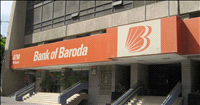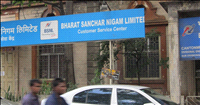A hometown perspective
By Matt McHugh | 04 Sep 2009
Pittsburgh, a city once described as “Hell with the lid taken off,”1 is where I took in the second-most-beautiful view in America.2 This Steel City3 is where I watched many a baseball game played in the brilliant afternoon sun on the green grass of one of the most beautiful parks in baseball.4 Even more than most cities, Pittsburgh seems to resist neat categorization or succinct description.
 |
| A view down the deserted length of the Andy Warhol Bridge (formerly the 7th Street Bridge), from in front of the Warhol Museum |
As scheduling conflicts prevented us from setting out together, I was left to begin this journey solo. I headed down to the Warhol Museum.
The Warhol
Situated on the corner of two nondescript streets is an attractive but unexceptional building that houses the Warhol Museum. This struck me as somewhat incongruous, since Andy Warhol was known for his avant-garde art; even his hair was noteworthy — platinum blond, long and unkempt. The interior of the museum, however, better fit my conception of the man.
Warhol’s belief was that art was to be found in everyday life and in everyday tasks, and his brand of pop art exhibited that ethos; his silk screens of Campbell Soup cans are iconic pop art images.5 They were on display, as were his collection of silk screens featuring Jackie Kennedy and his tracings and drawings. Also on display were Warhol’s films, which follow ordinary folks through life, and many of his numerous photographs, of celebrities and unknowns, posed and candid. After all, it was Warhol who said, “In the future, everyone will be world-famous for fifteen minutes.”
 |
| The opulent Austrian room lit up by the exterior light reflecting off the mirrors, tabletop, and chandeliers |
Though more aptly described as an art gallery than a museum, The Warhol showcases a mix of older and contemporary work that tends toward social commentary, more aimed at provoking thought than inspiring awe. To that end, though, it succeeds famously.
Stepping out of the Warhol into the brilliant mid-afternoon sun, and still alone, I told myself I'd head to Mt. Washington, famous for its views of the city, as long as the clouds stayed away, and Sarah would just have to understand.
Mt. Washington and the Duquesne Incline
 |
| The open space of the Indian room aims to recall a courtyard / classroom |
One of the written pieces is an excerpt from George Washington’s diary from his first trip through the area. He discusses the vertex of land located at the confluence where the Allegheny and Monongahela Rivers form the Ohio — the three rivers for which Pittsburgh is known.8 The incline’s observation deck offers a bird's eye view of that piece of land, where presently shiny skyscrapers funnel into a grassy park, culminating in a large fountain at the tip.
The area has been dubbed the Golden Triangle for the nighttime glow of the buildings' lights in their unusual, river-dictated geometry. In fact, USA Weekend Magazine rated this the second-most-beautiful view in America.
Having descended the incline, I strolled along a walkway bordering the river. It was a sunny afternoon, and seeing everything at such proximity, and from that perspective, brought home the colossal beauty of the river, the bridges, and even the towering buildings across the water.
Thanks to a second, ascending incline ride, I exited the incline building onto the appropriately named Grandview Avenue, which, skirting the bluff, took me by a handful of railed, pier-like projections that all provided panoramic and majestic views of the rivers, bridges, and buildings below. One of these piers was being appropriated for a marriage proposal, red roses having been laid down to form the outline of a heart by friends of the aspiring fiance; I was told he was en route with his girlfriend. After heading back to the Duquesne Incline for some photos of the Golden Triangle, I called it a night.
The Pittsburgh Sports Museum
Experiencing Pittsburgh without acquainting oneself with its sporting tradition is like visiting ancient Rome and missing the Colosseum. Pittsburghers at all points of the occupational and socioeconomic spectra pride themselves on what they see as the blue-collar work ethic of their town and their contribution to it.
Before I set out for the Pittsburgh Sports Museum, I made sure Sarah, a die-hard Penguin fan, could accompany me. It's in this museum — occupying one of the four floors of the Heinz History Center — where a visitor can explore in depth the sporting history that has, maybe in reality, or maybe just in the collective imagination, mirrored its city’s personality.
On display is a video of the winning shot hit over the outfield wall by the Pirates’ diminutive second baseman in the 1960 World Series championship. It was that home run, in the bottom of the ninth of the final game of the series, that felled New York’s mighty Yankees.9
Also on display were the golden, diamond-filled championship rings of the reigning Super Bowl champion Steelers.
Sarah was eager to check out the ice hockey section and its focus on the hometown Penguins. Little did we know they would go on to win the Stanley Cup a few months later.10 Standing in front of an ice hockey goal and behind a cut-out of a goalie’s body, Sarah and I each got to pose as hockey anachronisms — behind modern uniforms and pads, but with our faces bare, we recalled those fearless, battle-scarred, maskless goaltenders of yore.
We took photos.
The Strip District
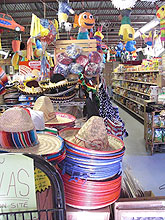 |
| Sombreros, pinatas, and Latin-American foodstuffs are all available in Reyna's Mexican–Caribbean Store |
You can't walk down a single block in the Strip without experiencing multiple colours, aromas, and cultures. The bright-red storefront of the S&D Polish Deli, the Mexican-flag green in the sign of Reyna's Mexican–Caribbean Store, and the red-and-white-striped motif of St. Stanislaus Kostka Church all caught our eyes.
Speciality shops and ethnic groceries line the streets. Even though it was a relatively slow day, as we moved down the pavement, we had to cut right and left around shelves of St. Patrick's Day apparel and tables piled high with bandanas; we had to bob and weave around stacks of Steeler T-shirts and watches on display.
As I examined a piece of pre-wrapped fudge in a convenience store, the clerk told me to take it for free. I asked why, and he compromised and let me pay him a quarter for it because it was new, he'd tried it, and he hadn't particularly liked it.
(I thought it was pretty good.)
The cashier in the Latin American–Caribbean store puzzled with Sarah and me over the appeal of the seasoned crickets and candied scorpions sold there. The man behind the counter in the coffee bean store/fine food shop/cafe empathized with Sarah's and my seemingly genetic dislike of coffee, telling us that he, too, had disliked coffee until he had a liberating conversation with his father.
“You don’t not like anything — you give it a try,” commanded his dad. Now, as the reader no doubt expected, he loves it. When asked if his life is better for it, he replied, “Sure. I’m in the crowd.”
The strip has a character — and characters — all its own.
The Cathedral of Learning and the Nationality Rooms
 |
| The Cathedral of Learning towers above the University of Pittsburgh campus |
Upon entering the first floor, we found students sitting and milling about as if unaware they’d been transported from a university study area to a Gothic cathedral. Light fixtures — part lantern, part flood light — hang from two-storey-long lines secured to a ceiling three storeys high. The ceiling is a choppy ocean, always sloping up or down, cresting at various points along ridgelines that spread like pleached branches and connect the tops of the pillars that rise like sinewy stone tree trunks from the floor below.
On the first and third floors of the building are twenty-seven nationality rooms.13 Each room is built and decorated in the style of a different country at a certain era. The Norwegian room, modelled after an 18th-century peasant's house, was all dark wood and thick beams, and had a fireplace. The Syria-Lebanon room had walls with fine gold-and-silver leaf and satin cushions. Unsurprisingly, it had been a wealthy trader's house.
The Austrian room was both bright and extravagant, with two chandeliers, three heavenly scenes of sky blue and cloud white painted on the ceiling, and mirrors that reflected the daylight entering through the windows as well as the white paint and gold trim in the room. It was inspired by a famous concert hall in an Austrian palace.14
We headed up to the Indian room and found it surprisingly bright and sparse. It was based on a courtyard/classroom typical of those at the ancient Nalanda University. On the back wall, on a background of white, were six niches. Each had a white, wall-attached statuette; one was the Buddha, the other five, Bodhisattvas.15 I thought the white, moderately decorated columns and moulding, the light-brown rows of wooden bench–desks, and the light brownish-red of the brick walls combined to give the room a fresh, clean look squarely between the utilitarian ascetism of some of the rooms and the lavish luxury of others — a kind of middle-path decor.
We left the nationality rooms only when the attendant came around to close up.
Though it may not be one of the big-name cities that first come to mind when considering U.S. travel, Pittsburgh has an eclectic mix of unique attractions, both modern and historical, and a friendly nature. And though it was once known more for industry than artistry, more for grime than the sublime, in 1990, Brendan Gill, then architecture writer for The New Yorker, wrote “The three most beautiful cities in the world are Paris; St. Petersburg, Russia; and Pittsburgh. If Pittsburgh were situated somewhere in the heart of Europe, tourists would eagerly journey hundreds of miles out of their way to visit it.”
1. Writer James Parton >> back to top
2. Pittsburgh is the only city to have twice been ranked “America's most liveable” by Places Rated Almanac >> back to top
3. Pittsburgh's nicknamed of “The Steel City” is attributable to its role as an industrial hub in the early 1900, when it produced as much as half of the U.S.'s steel. >> back to top
4. PNC Park, home of the Pittsburgh Pirates baseball club, is consistently ranked among the most beautiful baseball stadiums in Major League Baseball. >> back to top
5. Andrew Warhola, better known as Andy Warhol, was a famous creator and proponent of pop art. He was born in Pittsburgh in 1928, though he spent most of his life in New York City, where he moved at the age of 20. >> back to top
6. Pittsburgh has two inclines. The other is the Monongahela Incline. It's less tourist-friendly and more utilitarian than the Duquesne Incline, though its lower station is right next to Station Square, which contains an amphitheatre, a mall, and many restaurants, bars, and clubs. >> back to top
7. There is also a small museum that offers a fifty-cent tour and up-close viewing of the machinery that pulls the cable. >> back to top
8. That piece of land struck Washington as a good location for a fort. This was a somewhat universal opinion, and on that spot would first sit the French Fort Duquesne (a brick outline of which remains), and later the English Fort Pitt. >> back to top
9.The New York Yankees had won 9 of the previous 13 World Series championships. The Pittsburgh Pirates had gone 35 years without winning one. In the 1960 series with Pittsburgh, New York scored 55 runs overall. Pittsburgh scored 27, with each of its four wins coming by a single run. >> back to top
10. The Stanley Cup is the championship trophy of the National Hockey League. >> back to top
11. A type of fish >> back to top
12. The Cathedral of Learning is the second-tallest educational building in the world, next to the Main Building of M. V. Lomonosov Moscow State University. >> back to top
13. The idea, born in 1926, when ground was being broken on the Cathedral, was to contact local ethnic groups and ask them to construct and decorate rooms that communicated their history, art, values, traditions, and folklore. Because of the city demographics of that time, the first floor consists almost solely of rooms dedicated to European countries. The newer rooms, on the third floor, expand the program’s geographic reach to, among other regions, Africa, Japan, and India. >> back to top
14. The Haydnsaal in Schloss Esterhazy at Eisenstadt >> back to top
15. The room is decorated to recall “India’s Golden Age,” between the fourth and ninth centuries. The statuettes are modelled after those on a portion of Stupa 3 at Nalanda at that time. >> back to top












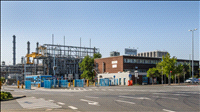

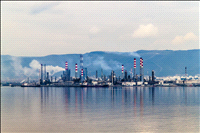
.jpg)
